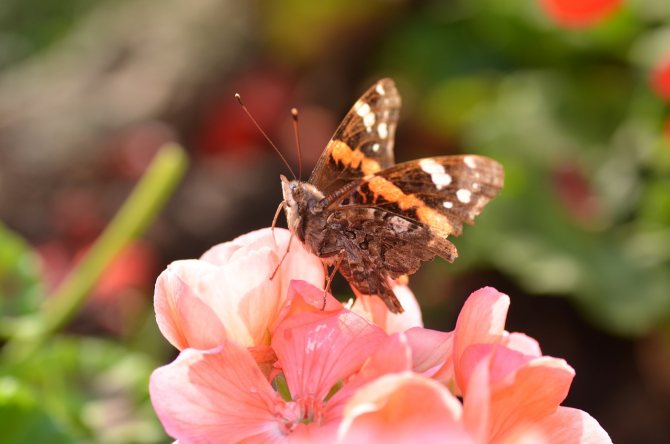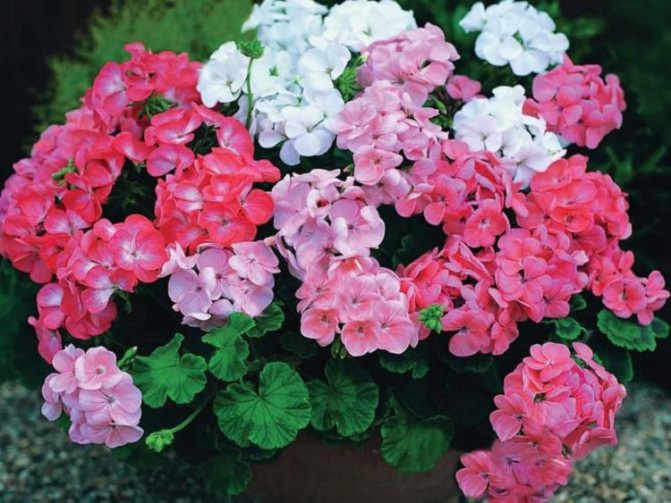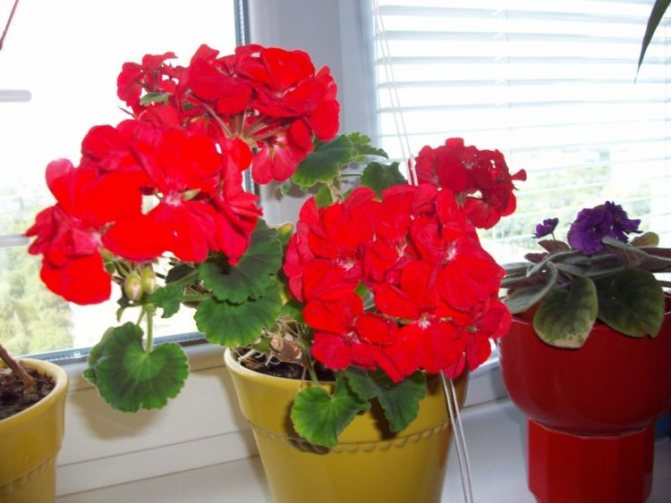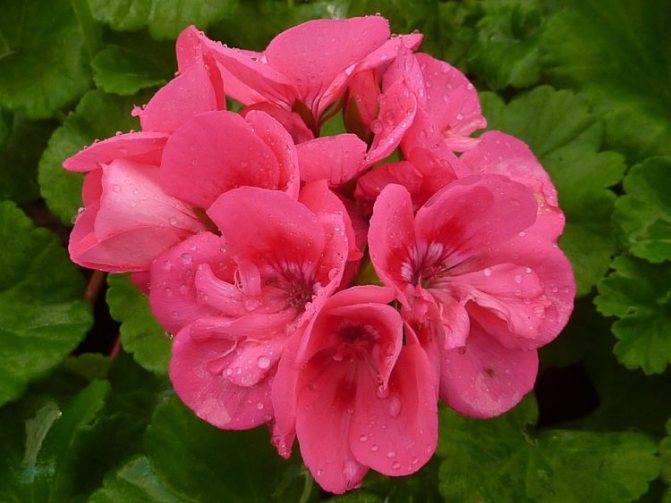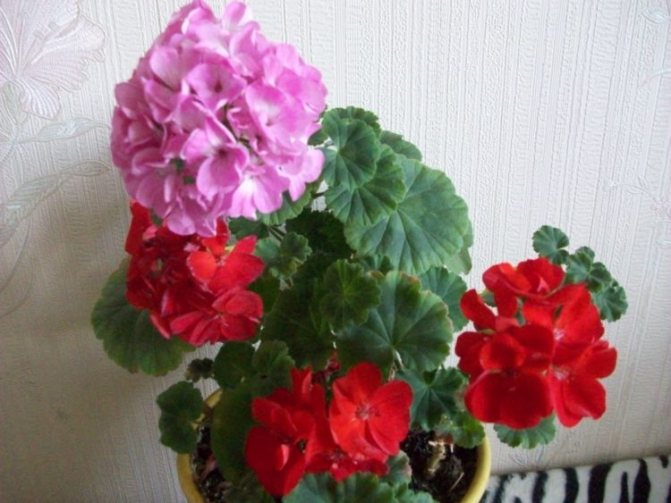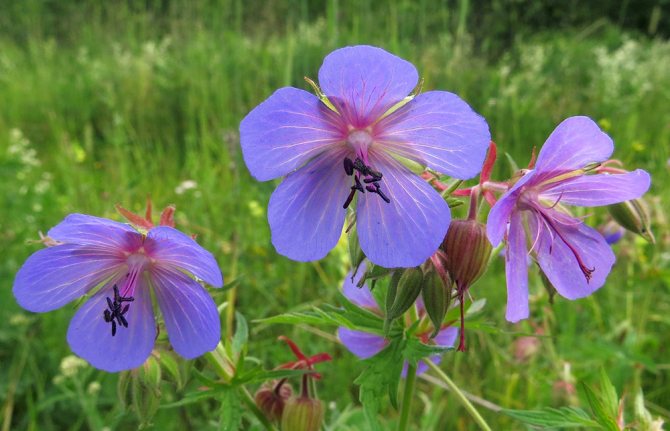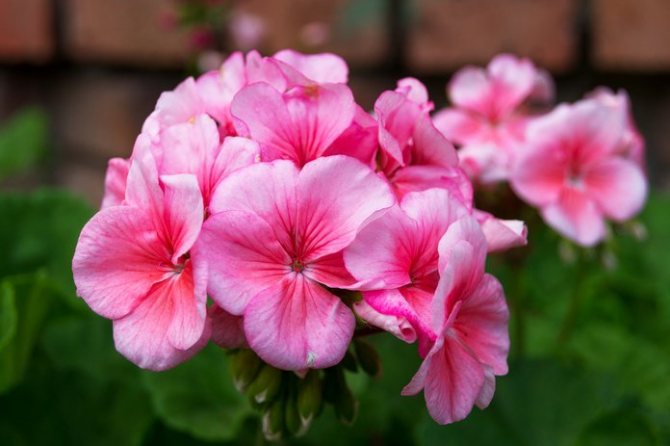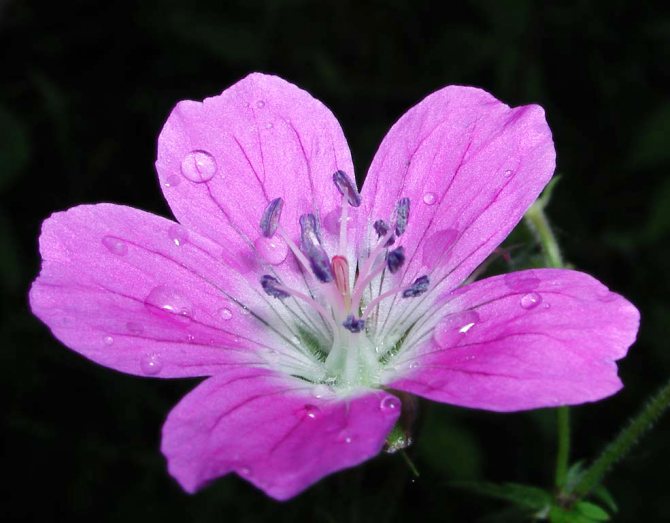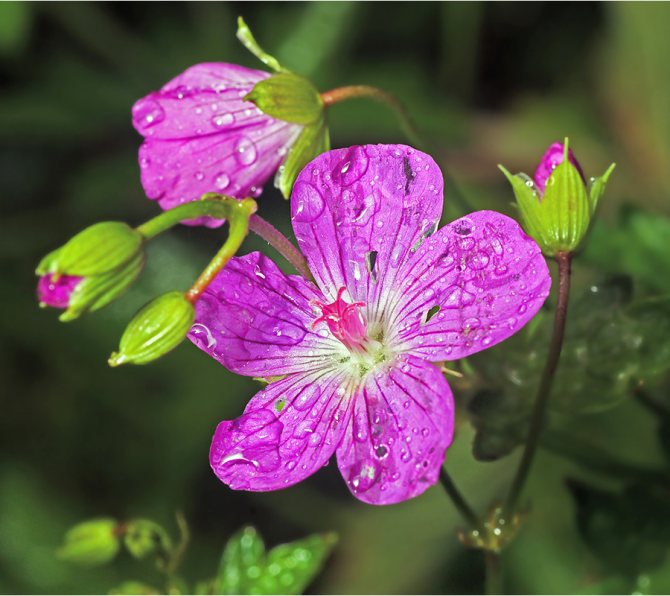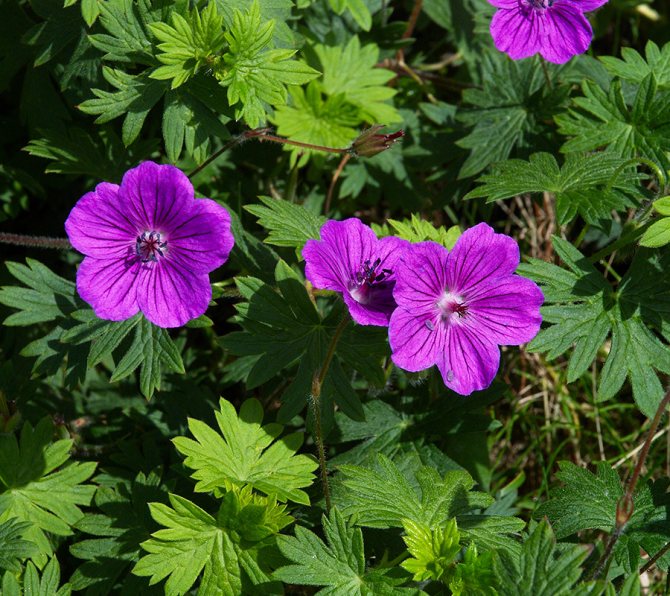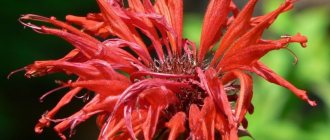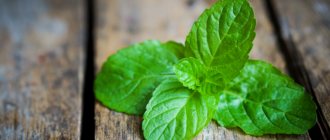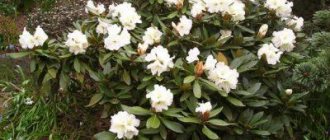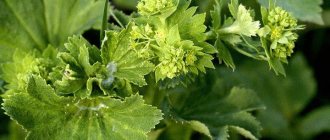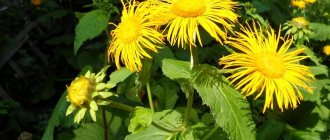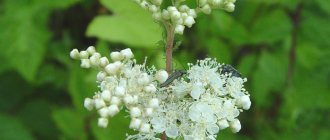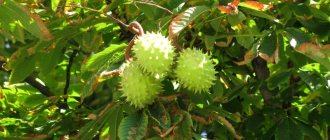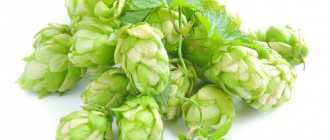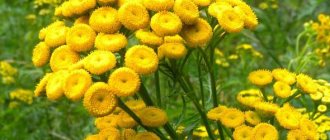The healing properties of geranium leaves
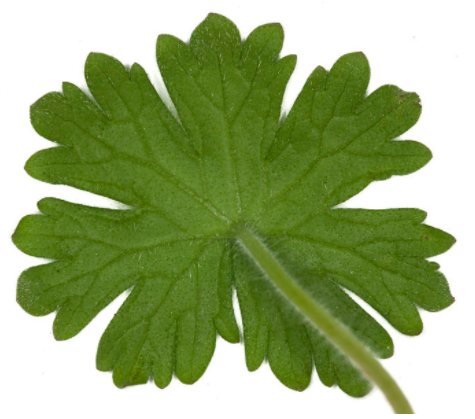
Due to the ascorbic acid, amino acids and flavonoids contained in geranium leaves, medicines based on them have pronounced antibacterial, anti-inflammatory and decongestant effects. In addition, infusions and vapors of geranium leaves effectively eliminate pain, heal wounds and regenerate the skin.
Also, the leaves and stems of geraniums contain (in small concentrations) alkaloids and cardiac glycosides. They promote vasodilation, lower blood pressure, and have sedative properties. According to a number of studies, plant alkaloids inhibit the growth of neoplasms.
For the preparation of effective medicinal preparations and infusions, fresh and dried geranium leaves with petioles, plucked during the period of budding and flowering, are best suited.
Chemical composition
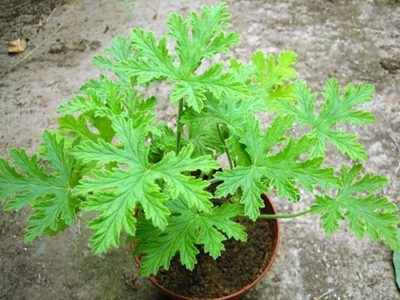

The composition of plant materials includes the following components:
- flavonoids;
- catechins;
- glucose and fructose;
- saponins;
- tannins up to 4%;
- pectins;
- organic acids;
- essential oil;
- phytoncides;
- carbohydrates and minerals, especially a lot of calcium;
- carotene;
- vitamins;
- alkaloids;
- tannins;
- starch.
The green mass of geranium contains another valuable component - geraniol. This aromatic alcohol-containing substance has antimicrobial and antibacterial properties. Used in perfumery.
However, when the natural component is abused, the strongest allergic reactions are manifested.
The healing properties of the geranium flower
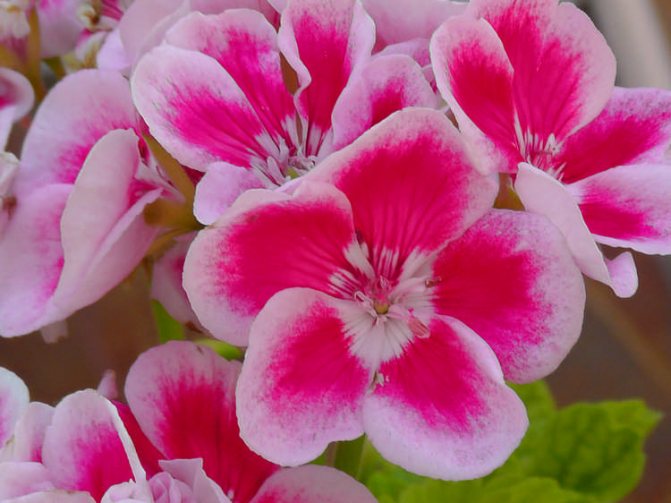

In addition to biologically active amino acids and flavonoids, geranium flowers contain healing essential oils, tannins and astringents. Inhalation mixtures and rinsing solutions with geranium flower extracts are effective for respiratory diseases. Medical applications and baths with oil and water infusions help with skin diseases, vaginitis, cystitis, hemorrhoids.
Also, medicines from geranium flowers are able to lower blood pressure, regulate sugar levels, and have a sedative and delicate hypnotic effect. The efficacy of geranium flowers has also been proven in diseases of the thyroid gland.
For the preparation of medicinal products, it is preferable to use fresh and dried geranium flowers collected at the beginning of flowering. During this period, the concentration of nutrients in them is maximum.
Features of the
The fragrant perennial is characterized by rounded leaves and branched stems. The flowers are small in size, the color is varied. The characteristic feature of scented geranium is the smell.
Back in the 16th century, Europeans noticed that this amazing aroma carries many useful qualities. At one time, geranium was considered the "flower of the poor", because to a greater extent it was grown by poor people. The exuded smell helped to get rid of burning, soot in the room, cleaned the air from toxic compounds, excess dampness. Later, scientists confirmed the presence of antibacterial properties.
The fragrant flower is a regular on school windowsills. Since the exuded substances kill dangerous microflora and scare away harmful insects.Geranium and its essential oil are often used in folk medicine and cosmetology.
Geranium fragrant indications and contraindications
Water and oil infusions of fragrant geranium are recommended:
- as wound healing agents;
- for resorption of hematomas and removal of puffiness;
- with otitis media and other inflammatory ear diseases;
- with ear and toothache;
- with exacerbations of hemorrhoids;
- with herpes;
- as an aid in persistent hypertension.
Contraindications to the treatment of fragrant geraniums:
- low pressure;
- acute stage of cystitis or urolithiasis;
- coronary artery disease;
- pregnancy and lactation;
- tendency to allergic reactions to herbal remedies.
Application
Indoor geranium is used to treat many diseases. Here are the most popular applications.
- Heart and cardiovascular system. The medicinal plant normalizes the work of the heart muscle, evens out the heart rhythm. If you put a piece of geranium on your wrist, you can bring your blood pressure back to normal. Flowers and leaves will help relieve headaches caused by vascular spasms.
- Diseases of the upper respiratory tract: acute respiratory infections, acute respiratory viral infections, tonsillitis. Pelargonium relieves symptoms (runny nose and cough), relieves sore throat. To do this, you need to gargle with an infusion of leaves, and freshly squeezed plant juice can be dripped into your nose.
- The gastrointestinal tract. Geranium reduces the acidity of gastric juice and relieves chronic gastritis.
- Diseases of the liver, gallbladder, biliary tract. Just the presence of a medicinal flower in the house relieves the condition of a chronic patient.
- Otitis. For treatment, you need to slightly knead the leaf in your hands, roll it into a tube and place it in your ear.
- Toothache. Crushed leaves of home geranium are applied to the aching tooth. Essential oils and phenolic compounds will relieve discomfort. But the plant cannot cure caries, so you can't do without a visit to the dentist.
- Rheumatism. Compresses with essential oil and the intake of the infusion of fresh leaves by mouth relieve pain. For a compress, rub the leaves into gruel and apply to the sore spot for one hour. After this time, the greens must be replaced.
- Kidney stones and salt deposits.
- Sedative. Geranium decoction is used to normalize the state of the nervous system. Pour a tablespoon of dry meadow geranium with a glass of boiling water and cook over low heat for 10 minutes. Let the broth brew for an hour, strain, bring the volume to the original chilled boiled water. Drink two tablespoons up to five times a day.
- Geranium is also able to stop mild bleeding. For example, if a nosebleed.
The plant is able to alleviate the condition for many diseases. However, in acute cases, it is best to see a doctor.
Indoor geranium medicinal properties
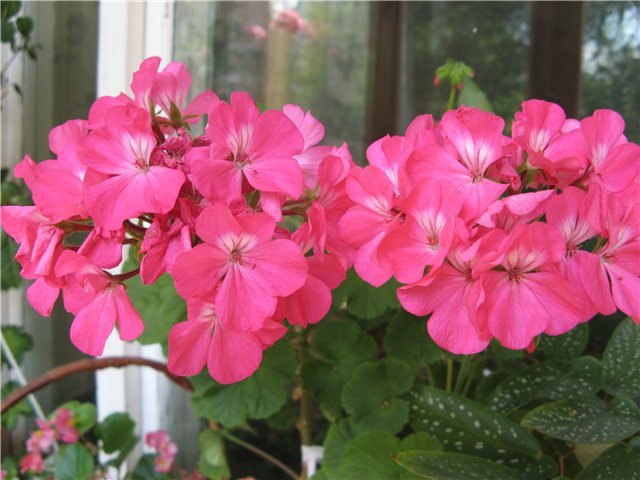

Medicinal properties of room geranium:
- antiseptic;
- anti-inflammatory;
- anesthetic;
- hypotensive;
- antiviral;
- sedative;
- sugar-regulating.
Folk medicines with room geraniums are effective:
- as an adjuvant in acute respiratory diseases;
- with headache, ear, toothache;
- with periodontal disease and glossitis;
- with inflammation and bleeding of the gums;
- with hemorrhoids in the acute stage;
- for the prevention of diabetes;
- with hypertension;
- with neurasthenia and neuroses.
Contraindications for room geranium include:
- exacerbation of gallstone and urolithiasis;
- heart failure;
- pregnancy and lactation;
- individual intolerance to plant components.
Harmful properties
Unfortunately, fragrant geranium has not only positive qualities, but also negative ones. When taking herbal medicines, you should pay attention that they can provoke an increase in blood viscosity, and also have a hypotonic effect.
It is recommended to do an allergy test before taking it.
Fragrant geranium juice is a poisonous substance. You cannot use it in concentrated form. It is advisable to observe the proportions when preparing the medicinal product.
Geranium meadow medicinal properties
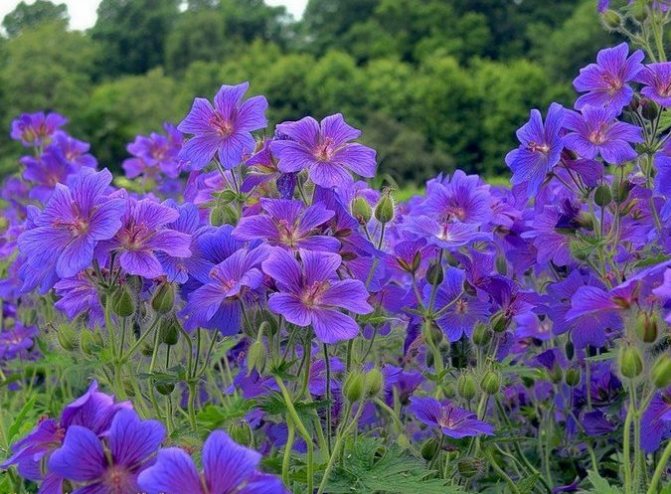

Meadow geranium is valuable:
- antibacterial and antiviral properties;
- effective wound healing action;
- anti-inflammatory and decongestant properties;
- the ability to quickly relieve toothache and ear pain;
- pronounced hypotensive properties;
- diuretic effect;
- oncoprotective action.
What kind of plant is indoor pelargonium and what are its useful qualities?
Geranium is a perennial herb of a warm climatic zone. It has branched stems, rounded leaves on long petioles. Many types of geraniums are popular indoor flowers. In folk medicine, geranium is valued for its bactericidal, antiseptic, hemostatic, anti-inflammatory, analgesic effect. Family: Geranium.
Indoor geranium, or pelargonium, is not only a beautiful and unpretentious flower, but also a “home doctor”. Healing properties of geranium:
- bactericidal;
- wound healing;
- antispasmodic;
- pain relievers;
- soothing;
- relaxing;
- absorbable;
- hemostatic;
- anti-inflammatory;
- decongestants;
- constricting;
- softening;
- anti-aging;
- antivirus;
- antibacterial;
- insecticidal;
- diuretics;
- immunostimulating.
The medicinal properties of pelargonium are found in leaves, flowers, roots, and stems. In folk medicine, leaves are most often used. Decoctions, infusions, alcoholic tinctures, oil extract are prepared from them. Essential oil is used as a component of ointments, creams and lotions.
Read more about the beneficial properties of the plant for the home and human health in our material.
The healing properties of the leaves
The medicinal properties of geranium leaves are determined by their composition. They contain:
- essential oil;
- phytoncides;
- flavonoids;
- pectins;
- resin;
- gum;
- glycosides;
- tannins;
- organic acids;
- minerals (especially a lot of calcium);
- carbohydrates;
- saponins;
- coumarins;
- starch.
The composition contains geraniol. It is a fragrant substance that has an antimicrobial effect. Geraniol is widely used in cosmetology and perfumery.
Does smell good or bad affect a person?
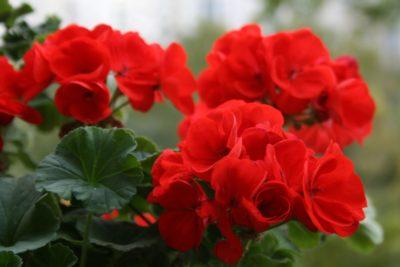

Pelargonium phytoncides have antimicrobial effects. This plant saturates the air with essential oils that balance the processes of arousal and inhibition. The scent helps relieve headaches, relieve fatigue, normalize sleep, and get rid of nightmares. It is used as a perfume in cosmetic and perfumery products: soaps, creams, sprays, lotions, perfumes.
Geranium has found its place in aromatherapy. Its scent promotes recovery from minor losses or unpleasant communication. Has a beneficial effect on well-being, increases motivation. Helps fight insecurity and inferiority complexes.
Returns the brightness of sensations, gives sensuality. The smell of pelargonium can be treated as follows. Place the plant on the table, sit at a distance of 60 cm from it and breathe through the nose. First, take three deep breaths, then inhale the smell evenly and calmly for 10 minutes. It will take 15 - 30 procedures. It all depends on the circumstances and characteristics of the organism. A large number of geranium species are known. They all have beneficial properties.
Meadow geranium indications and contraindications
Traditional medicines with meadow geranium are used:
- with inflammatory diseases of the ENT organs;
- with respiratory infections;
- in the treatment of inflammation in the oral cavity;
- with chronic otitis media;
- with high blood pressure;
- with chronic cystitis;
- with hemorrhoids.
Means containing meadow geranium should be taken with caution:
- with acute inflammation of the kidneys and bladder;
- during pregnancy, lactation;
- with ischemic heart disease;
- with low blood pressure;
- with a tendency to allergies.
Contraindications
The following categories of people are not advised to use geranium and preparations based on it:
- pregnant and lactating women;
- children under 12 years old and the elderly;
- in the presence of individual intolerance;
- with chronic diseases of the gastrointestinal tract, liver, kidneys;
- with thrombophlebitis and varicose veins;
- with low blood pressure;
- people suffering from bronchial asthma.
Before using the drugs internally, it is recommended to consult with your doctor.
Geranium red medicinal properties and contraindications
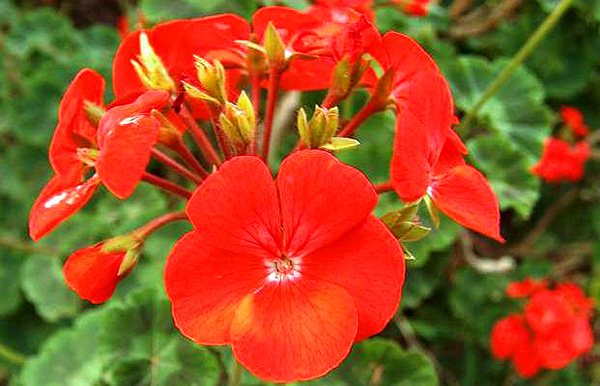

Blood red geranium properties:
- antibacterial and antiviral;
- pain relievers and decongestants;
- hemostatic;
- wound healing and regenerating;
- sugar reducing;
- astringents;
- sedatives.
Medicines with red geraniums are recommended:
- with otitis media;
- with skin diseases;
- with shallow burns;
- with gum disease and stomatitis;
- with inflammatory diseases of the genitourinary organs;
- with diseases of the thyroid gland;
- with inflammation, bleeding of hemorrhoids;
- with herpes;
- for the prevention of diabetes;
- with neurasthenia and various types of neuroses.
Traditional medicines with red geranium are contraindicated:
- with gastritis and stomach ulcers;
- with pancreatitis;
- with heart failure;
- with exacerbations of kidney disease;
- during pregnancy, lactation.
Essential oil
The essential oil is obtained from the leaves of perennial domestic or meadow geraniums by steam distillation. Its aroma is warm, floral, with oily notes, vaguely reminiscent of the scent of rose flowers. It is colorless, light, and has good fluidity.
The most popular use of geranium essential oil is in the treatment of diseases of the ENT organs. Many are limited only to this, although the scope of application is huge.
- This remedy for depression, increases mental, physical activity.
- Eliminates skin diseases: dermatitis, eczema. Heals burns, frostbite.
- Effective pain reliever.
- Improves blood pressure, blood microcirculation in the heart muscle.
- Helps with neuralgia, neuritis, radicular syndrome.
- Helps with diseases of the "female" sphere. Normalizes hormones, relieves premenstrual syndrome, relieves menstrual pain. It is used for inflammation of the mammary glands.
Important!
Treatment with essential oils should not last longer than two to three weeks. After that, a break is required.
Geranium-based oil can be obtained independently, at home. To do this, you need to collect the young leaves with the flowers of the plant and grind them into gruel. Then place the herbs in a glass dish, pour medical alcohol in a 2: 1 ratio. Close the lid tightly, put in the sun to infuse. After two weeks, fill with olive or corn oil (1: 1 ratio to the total amount of infusion). Close the container tightly again, soak in the sun for another two weeks. Now the mixture must be filtered and poured into dark glass jars. Store your own oil out of the reach of children and animals.
Important!
Geranium should not be taken orally on an empty stomach. A high acid content will negatively affect the condition of the mucous membranes.
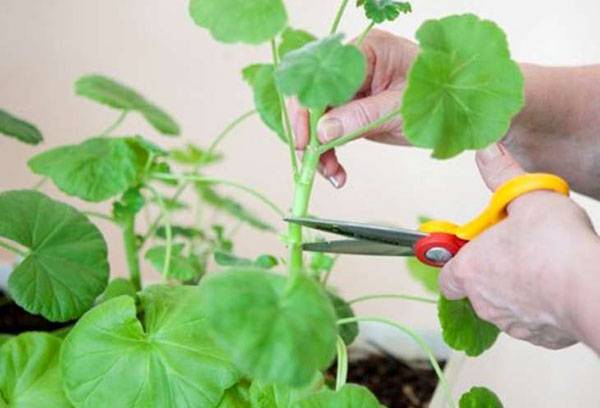

Treatment of geraniums at home:
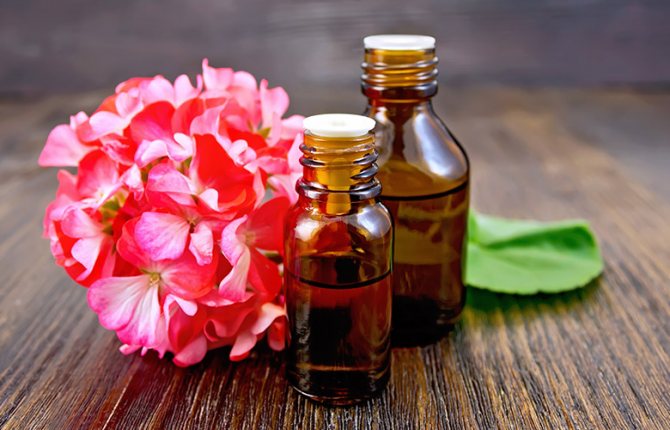

geranium leaf treatment, methods and recipes
Geranium leaves for hypertension. For rapid normalization of high blood pressure, a freshly torn leaf of fragrant or room geranium scalded with boiling water is applied to the wrist for 45-60 minutes.
Geranium leaves with panaritium (inflammation of the periungual tissues) and boils. Several fresh geranium leaves (preferably forest, not flowering or lemon) are crushed for 30 seconds. pour boiling water, strain, squeeze slightly. They are placed on the affected area, covered with a film, and fixed with a tissue bandage. The compress is left for 4-6 hours (you can overnight).Repeat 2 to 4 times a day.
Geranium leaves for toothache relief. A piece of a freshly torn geranium leaf is washed with running water, crumpled strongly, scalded with boiling water. After cooling, it is applied to the inflamed gum area or to a sore tooth. Hold until pain is relieved.
geranium for the treatment of ears, otitis media, methods of treatment
Effective means for eliminating inflammation and pain in otitis media are therapeutic wraps, applications, compresses with juice and infusions of geranium leaves and flowers. Important: you cannot drip medicine from geranium into the ear canal.
Treatment of otitis media with juice of geranium stems and leaves
To prepare the remedy, use fragrant, non-blooming or meadow geranium. 10 leaves with stems are crushed. Scald with boiling water, then put on cheesecloth, twist a tight knot and squeeze out the juice. Dilute it with boiled water in a 2: 1 ratio. A dense turunda is made from a piece of cotton wool, moistened with a medicinal solution, shallowly (!) Injected into the ear canal. Leave for half an hour or an hour.
Oil tincture of geranium root for otitis media
5-7 roots of fragrant or room geranium are crushed. Squeeze out the juice. Mix in a 1: 1 ratio with vegetable oil. Insist 3 hours. The cotton turunda is impregnated with oil tincture, placed in the ear canal for half an hour or an hour. Repeat up to 4 times a day.
Healing application with geranium and oat flour
7-10 leaves and 3 inflorescences of room or red geranium are crushed. Add 1.5 tbsp. tablespoons of camphor alcohol and 65 g of oat flour (any grind). A soft doughy mass is prepared. Roll it up with a thick roller, wrap it around the sore ear, fix it with a cloth bandage. The ear canal is left free. Maintain the application for 1-2 hours. Repeat three times during the day.
ear treatment with geranium leaf, methods
Method 1. A leaf of room, fragrant or lemon geranium is slightly kneaded, rolled up in a tube. Shallowly injected into the ear. Leave until the pain disappears.
Method 2. A freshly plucked geranium leaf is scalded, cooled. In a warm form, apply to the sore ear. Fix with a thick napkin and bandage. Keep the compress for at least 1.5 hours. Can be left overnight.
treatment of hemorrhoids with geraniums, methods
Folk remedies based on geraniums effectively cope with the unpleasant symptoms of exacerbated hemorrhoids. They prevent inflammation of hemorrhoids, relieve pain and swelling, and reduce bleeding.
With external hemorrhoids, pharmaceutical phytopreparations and homemade tinctures with geraniums are taken inside, they make cool baths with concentrated decoctions of the leaves and flowers of the plant. For internal use, medicinal tampons with water infusions and oils of room, fragrant or meadow geranium are used.
Decoction of meadow geranium leaves from hemorrhoids
Three tablespoons of dried meadow geranium leaves are poured into three glasses of water (hot, but not boiling). After 3-5 minutes. placed in a water bath. Steamed for at least 45 minutes. Cool completely, then filter, squeezing out wet raw materials. Take an infusion of geranium three times a day for 3/4 cup until the acute symptoms are eliminated. For effective treatment, you need to prepare a fresh infusion of geranium leaves every day.
Steam fresh room geranium flowers for hemorrhoids
Half a glass of freshly picked flowers of room geranium is placed in a half-liter jar (you must first rinse it with boiling water). Pour boiling water over the "shoulders" of the jar. Cover tightly. Insist on a pair of geraniums for at least one and a half hours. Cool, filter. The remainder is wrung out. It is taken with exacerbated hemorrhoids twice a day, with an incomplete glass, until symptoms are relieved.
If it is not possible to take baths with geraniums, you can make a therapeutic application: dilute a small amount of chilled steam with water 1: 2, moisten a sterile gauze napkin with the solution and apply it to the anus for 30-40 minutes.
Healing bath with fragrant (meadow, room) geraniums for hemorrhoids
About 70-100 g of a mixture of geranium leaves and flowers are poured with boiling water (500 ml). Insist on a water bath for about an hour, after which, without cooling, filter. Dilute the infusion in 5 liters of cool boiled water. Take a medicinal bath with geraniums for hemorrhoids for 15-20 minutes.The procedure is repeated twice to three times a day, until the pain and swelling disappear.
geranium thyroid treatment, methods
Healing remedies from geranium - steam, water and alcoholic infusions - are actively used along with traditional medicines for the treatment of inflammatory diseases, hyperplasia and the prevention of thyroid dysfunction.
Geranium tincture on alcohol for inflammation of the thyroid gland
Fresh geranium leaves of red, lemon or non-flowering are washed and then dried on a napkin. Tamped in a half-liter jar (up to 3/4 of its volume). Pour to the top with an aqueous solution of medical alcohol (1: 1) or high-quality vodka. Insist 2.5 weeks in the dark. Then shake vigorously, leave to infuse for another week. The finished medicine is filtered. They drink geranium tincture in four courses: three times a day, a tablespoon for two weeks, a week break.
Healing collection with geraniums for thyroid dysfunction
25 g of fresh geranium flowers, 30 g of geranium root, 25 g of galangal root are crushed and mixed. For treatment, it is better to use forest or meadow geranium. Medicinal raw materials are poured with boiling water, after which they insist for at least 40 minutes. They are filtering. Take for inflammation of the thyroid gland, 0.5 tbsp. spoons of slightly warmed steam of geranium twice a day.
geranium goiter treatment, methods
Geranium and clay remedy for thyroid hyperplasia
With warm water, 75 g of gray clay is dissolved to a creamy consistency. Juice is squeezed out of 10-15 leaves of room or fragrant geranium (always with petioles and stems). Add it to the clay mass. The finished product is used for daily compresses for thyroid hyperplasia. The course of procedures is 3 weeks. You can make a compress with geraniums no longer than 20 minutes. and only once a day.
Therapeutic collection with geraniums for diffuse and nodular goiter
Mix: 1 part of freshly picked flowers and leaves of non-flowering or lemon geranium with 2 parts of dry tricolor violet and 1 part of hawthorn fruit. Measure out about a third of the glass of the mixture. Pour boiling water to the top, then steamed in a water bath for 40 minutes. It is taken with an increase in goiter by a third of a glass of strained geranium broth twice a day.
geranium neuritis treatment, methods
Application of geranium leaves for neuritis
A fresh leaf of a fragrant, lemon or non-flowering geranium is scalded, wrapped with gauze, applied to the affected area, secured with a warming bandage for 40 minutes. Repeat twice daily.
Remedy for neuritis with geranium and currant leaves
For the preparation of this folk medicine, it is better to use fresh raw materials. Mix 10 geranium leaves with 10 black currant leaves. Pour 300 ml of boiling water, then insist under the lid for 1 hour. They drink in five-day courses with a break of one week, a third of a glass four times a day.
Decoction of geranium flowers with arnica for neuritis
50 g of geranium inflorescences (fragrant, indoor or red is suitable) is mixed with 30 g of arnica. Steamed with a liter of boiling water, kept for 5 minutes. Then boil for 10-12 minutes. Cool and filter. Drink before going to bed every day. At one meal - half a glass of broth.
treatment of hypertension with geraniums, methods
Geranium leaves for hypertension
An easy way to quickly and smoothly normalize blood pressure is to chew a freshly plucked leaf of fragrant or forest geranium for 5 minutes.
Homemade drops from geranium flowers for hypertension
100 g of inflorescences of red, fragrant or forest geraniums are poured into 100 ml of high-quality vodka. Shake vigorously. Maintain in the dark for 12-15 days. They are filtering. Apply at elevated pressure, 15 drops of tincture of geranium flowers per 30 ml of water.
Geranium species
Botanists distinguish garden, meadow and indoor plant varieties belonging to this family. There are about 400 varieties in total.
Of course, we will not consider all this diversity in detail.The object of this review is indoor geranium (genus Pelargonium).
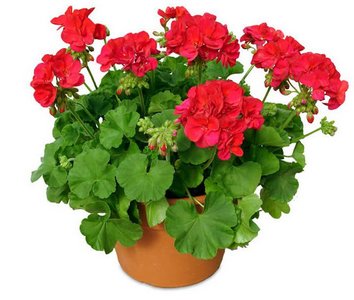

To begin with, a generalized description. These are herbaceous or semi-shrub plants with erect or falling stems, their flowers are smooth or velvety of a wide variety of shapes and colors, the leaves are round or cut, green or variegated.
Due to the abundance and variety of varieties (there are 250 of them), it is impossible to present a clear classification with detailed characteristics. The following varieties of pelargonium are commonly grown by amateur florists:
- zonal;
- ivy;
- royal;
- angel;
- unique;
- fragrant;
- fragrant.
Pelargonium zonal comes across most often. It is used to decorate both window sills and flower beds. The name is associated with a small spot in the middle of the leaves, which is usually lighter than the base plate. Flowers of various shapes delight the eye with bright colors: white, orange, coral, purple. You can't list all the shades.
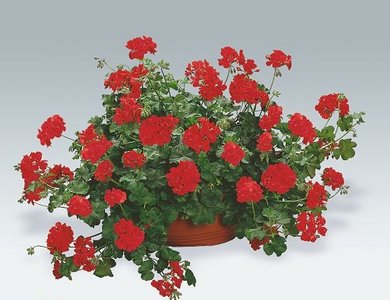

The ivy-leaved geranium variety got its name because of the climbing stems and five-pointed leaves. The shape of the flowers is varied, the colors in the palette are from white to wine and burgundy.
The royal geranium is the most capricious, but how beautiful! The petals are large (4-7 cm), fringed, the main colors are white, burgundy, pink and purple. A distinctive feature is bright contrasting spots or veins, giving the flowers a regal splendor.
The Angel geranium variety is often confused with the variety described above. The main difference is small inflorescences. Yes, and the "character" of such a pelargonium is unpretentious.
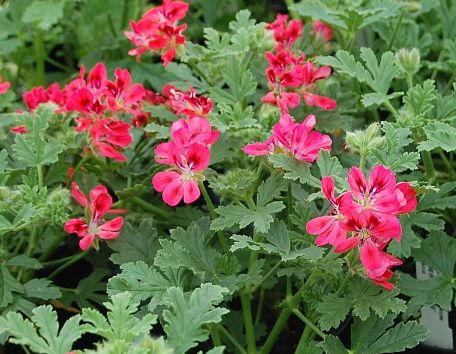

The flowers of the unique ones are also similar to the royal ones, but smaller (up to 2 cm). The leaves are dissected. Some varieties have a pleasant peach smell.
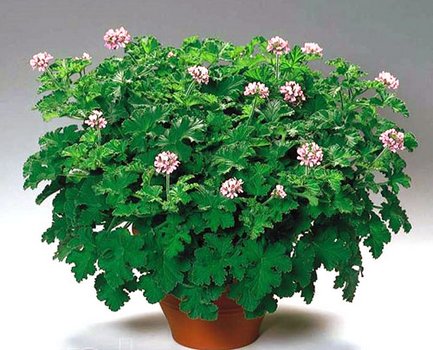

For lovers of pleasant aromas, we recommend that you pay attention to the pelargonium of the last two varieties in the above list of varieties. Yes, they look boring: the flowers are inconspicuous, usually white or pink. But if you touch the plant, it smells like grapefruit, apple, pineapple, rose or even pine needles.
Do not miss: Indoor flowers for your bedroom - we make the right choice.
We hope your ideas about pelargonium have already changed. But appearance and pleasant smell are not all advantages!
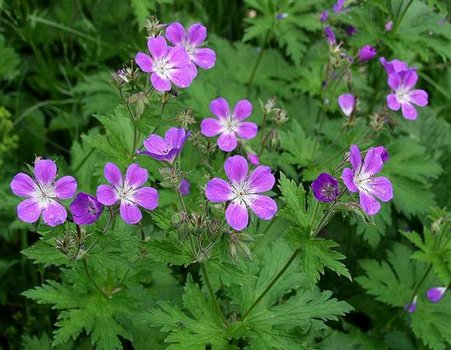

How to make geranium oil
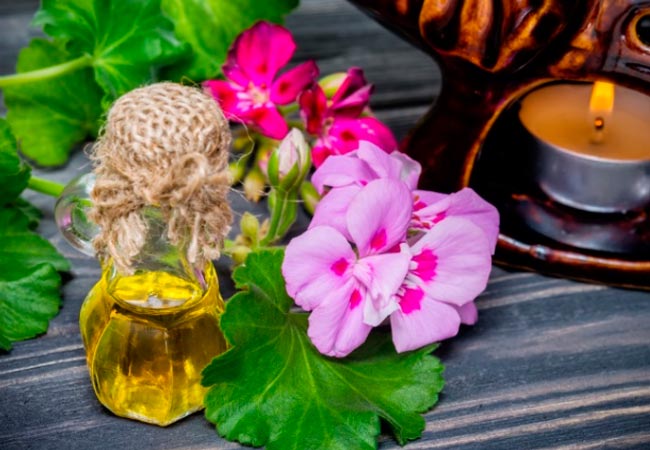

Geranium essential oil, saturated with valuable microelements, is successfully used in healing skin diseases, relieving toothaches and headaches, used for therapeutic baths and aromatherapy for migraines and neuroses.
Extracting concentrated oil from a medicinal plant at home is quite problematic. In addition, the yield of the finished substance will be scanty. Therefore, traditional healers recommend pharmaceutical phyto-oil or geranium extract in vegetable oil.
How geranium oil is prepared:
- Raw materials are prepared. Leaves with petioles and geranium inflorescences are mixed in approximately equal parts. Washed, dried completely, and then randomly crushed.
- A container scalded with boiling water (a small bottle with a wide neck or an ordinary half-liter jar is suitable) is filled with a prepared mixture of flowers and leaves for three quarters of the volume. Ramp down.
- Pour in slightly warmed (not hot!) Olive or refined sunflower oil. Seal tightly. Wrap with two layers of black polyethylene.
- Insist oil extract of geranium for 20 days at room temperature. It is better to place the container in a dark place.
- Strain the finished geranium oil. The remaining mixture of leaves and inflorescences is squeezed out. Store the medicated oil in the refrigerator.
Why you need to plant geraniums at home
✿ Fragrant leaves have anti-inflammatory and antimicrobial properties. They disinfect and purify indoor air. Thanks to this, pathogenic bacteria are destroyed - you and your loved ones will be under invisible protection from colds and flu.
✿ Protects against unwanted insects: mosquitoes, flies, moths, garden pests, etc. And the essential oil of the plant is considered a powerful natural repellent.
To protect against insects, a composition of 10 drops of ether, diluted in 1 liter of water, is prepared. The finished product is poured into a container with a spray bottle and used to treat the entire room.
The diluted oil is non-toxic and will not harm animals.
The product can also be used to protect against lice and fleas.
✿ The scent of a houseplant improves the energy in the house, protects it from scandals, quarrels and other negative emotions.
In addition, it relieves fatigue, improves mood, and gives a feeling of calmness and well-being. To ease the signs of stress and depression, rub the leaf in your hands and inhale its scent deeply. It quickly energizes, relieves irritation and relaxes the body.
✿ Geranium is considered to be a symbol of love. Therefore, it is advised to put pots with a plant in the bedroom to strengthen relationships in a couple or find a soul mate for single people.
✿ The plant has been used since ancient times as a talisman that saved from black power. With the help of geranium flowers, women adorned their hats, and men put them behind the cuffs of their sleeves.
Also, the flower was handed over as a talisman against evil forces, applying juice to the belly of a woman expecting a child.


Geranium in the streets of Italy
Geranium oil treatment, tips and recipes
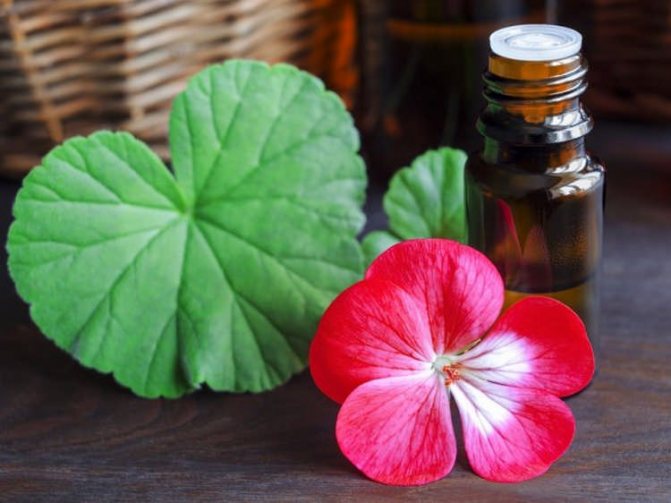

- For skin diseases - acne, herpes, eczema, dermatitis, ringworm and pityriasis, etc. - a thin layer of the product is applied to the affected areas three times a day. Geranium oil treatment is carried out until the symptoms disappear.
- For a smooth and effective reduction in blood pressure, a few drops of geranium oil are applied to the pulsating point of the wrist and gently rubbed into the skin without pressure.
- To relieve headaches, geranium oil is applied to whiskey. Persistent migraines are treated in the same way.
- In case of toothache, a cotton ball is soaked in a small amount of geranium oil and applied to the gum near the problem tooth. If the pain persists, the procedure is repeated.
- With periodontal disease and inflammation of the gums, therapeutic oil rinses are done several times a day. A teaspoon of geranium oil is taken in the mouth and kept for 5-7 minutes.
- For hemorrhoids, a tampon or gauze napkin with geranium oil is applied to the inflamed nodes.
- For neuroses and depressive states, geranium oil is added to aromatic baths.
- For a concentrated oil extract, it is better to use fragrant, indoor, blood-red, lemon and meadow geraniums.
- In case of any allergic manifestations and exacerbation of the symptoms of diseases, treatment with geranium oil should be discontinued.
It is important to understand that geranium medicines are used in addition to medicines prescribed by a doctor. The article is informational. We do not recommend using the listed folk recipes without first consulting a specialist.
Recipes
With sciatica and osteochondrosis Preparation and application:
chop the stem and leaves of geranium into gruel, apply to the painful area. Remove the lotion in an hour. Perform the procedure regularly, make fresh porridge every time.
With otitis media, accompanied by temperature Preparation and use:
30 g of leaves insist in 250 ml for half an hour, filter, drink ½ cup at a time.
Geranium for constipation Application:
Add 15 g of fresh leaves to 500 ml of boiling water, set aside for 8 hours, strain, drink during the day in small portions.
Skin inflammation on the face
cleaned using a mask with antimicrobial effect. To do this, a couple of crushed room geranium leaves are combined with aloe juice. The mass is applied for 15 minutes, washed off with chamomile broth.
The most important thing is the weather in the house.
What else can geraniums offer you? The value of this plant in the house is difficult to overestimate.Some people do not like the specific aroma that it exudes, but it is thanks to essential oils that the plant can take on the function of an ecologist. It can help neutralize unpleasant odors, which is especially recommended for homes located near highways. This plant perfectly cleans dirty air, which means it is perfect for city apartments.
Read also Why do you need an air valve for sewage
The opinion of the older generation
Folk wisdom has been formed for centuries, so it is necessary to listen to those who received knowledge directly from folk herbalists. They can tell a lot and will definitely advise you to buy geraniums for home. Is it possible to keep a flower at home, which is a home doctor, a magical plant and a real talisman? Of course, it is possible and even necessary. However, it should be borne in mind that the properties of this plant are diverse, it can bring both benefits and harm.
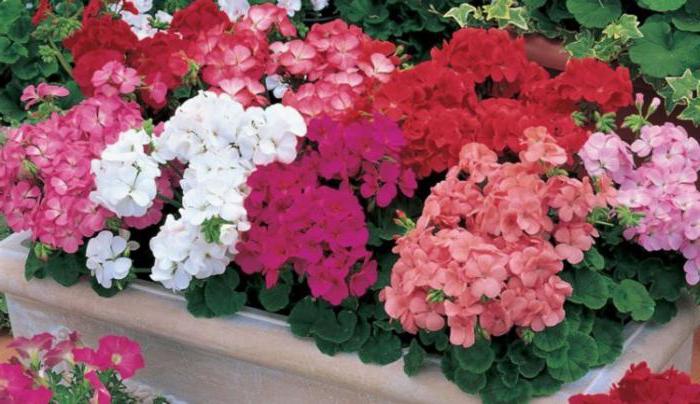

Where and how to get it?
Recently, geranium has regained its former popularity and it will not be difficult to acquire it. Practically in any flower shop you can find seeds or ready-made flowering geranium bushes. You can also go to online stores and various sites on which the choice of plants will be more and more interesting.
Recommendation! If you are interested in rare and unusual types of geraniums, then you should contact florists and experts abroad who can send you seeds of different types.
Geranium is a unique and wonderful houseplant that even a beginner can grow. If you are looking for a beautiful plant for your windowsill, you should turn your eyes to geranium, because it is not only a beautiful flower, but also a real storehouse of healing properties.
Testimonials
Catherine:
“I love fragrant geranium, but it stretched out a lot for me. I put the pot on top of the better-lit kitchen window. My geranium has become more luxuriant. "
Love:
“I took up indoor flowers, found cuttings of dark red and pink terry pelargoniums. When my plants got big, I shared the shoots myself. And then something happened that made me believe in the omens associated with geraniums. The people to whom I gave the cuttings were evidently not very kind, because the geraniums perished both for them and for me. "
Procurement of raw materials
When preparing raw materials, first you need to determine which species your plant belongs to, because the drying efficiency and shelf life depend on the right choice. Even when collecting, you should very carefully select the raw materials, because if you confuse geranium with another plant, then you can spoil the entire composition and, instead of the desired therapeutic effect, harm your health.
And also it should be borne in mind that at the cathedral of meadow geranium, the rhizomes and the ground part should be taken as the basis.
- Geranium harvesting is carried out during its flowering, from the beginning of June to the end of autumn. In some varieties, in addition to flowers, roots are also harvested, but they need to be dug out only in late autumn, after the entire upper part of the plant has died out.
- The collected raw materials should be dried in the open air or attic, the main thing is that the temperature in which the raw materials are located does not exceed 45 degrees and the air is not too humid. Under these conditions, the shelf life can be up to one year in a glass jar.
- If the geranium variety is blood-red, the collected raw materials should be stored in special cloth bags and used, if necessary, for medical purposes. The shelf life in this form can be more than two years.
Cosmetology
Geranium in cosmetology is most often used in the form of an essential oil. It is used in its pure form. They are also added to various masks, enrich cosmetics with them - hair shampoos and face creams.
- Geranium essential oil for hair. Can be rubbed into scalp to promote hair growth. Helps with dandruff and head lice.To prevent dry skin and brittle hair, it is recommended to drip oil onto a comb and comb the strands thoroughly. Geranium can be mixed with other essential oils - cedar, rosemary, burdock, almond.
- Geranium essential oil for face. The tool helps with acne, neurodermatitis, boils, fungal infections, dry, flaky skin. Eliminates scars, promotes rapid healing of wounds, cracks and scratches. Especially useful for sensitive and dry skin. It has a rejuvenating, tonic effect.
Preparation of cosmetic ice for the face:
- Take a glass of still water.
- Pour in 1 tbsp. l. milk and fresh lemon juice.
- Add 3 drops of geranium essential oil.
- Stir well.
- Pour into molds and place in the freezer.
Ice cubes can be used to wipe your face in the morning and evening. Also, as a tonic, you can use decoctions and infusions of pelargonium.
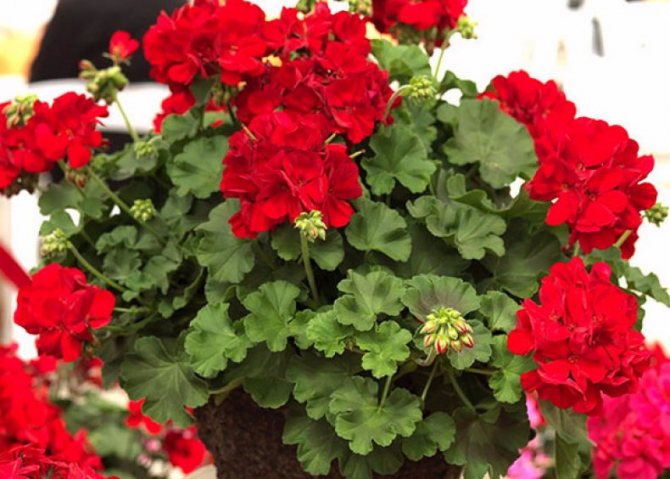

Reproduction
The breeding procedure for geraniums can occur in three ways:
- propagation by cuttings;
- reproduction by seeds;
- reproduction by dividing the bush.
The first method is quite simple to implement. It is necessary to choose a stalk on which there are 3-4 leaves and cut it off with a sharp knife. Then he is allowed to lie down for several hours in order for the cut to dry out. After that, the cutting is placed in water, or in a mixture of peat and sand, to take root. After a few weeks, it can be safely transplanted into a pot.
The second method is quite long and therefore less popular. Seed propagation is usually used when a new geranium variety is being grown. It is best to plant seeds in early spring, having previously treated the ground with a solution of potassium permanganate in order to protect the plant from diseases and bacteria. After sowing the seeds, the surface is sprinkled with a thin layer of sand and covered with foil in order to create a greenhouse effect.
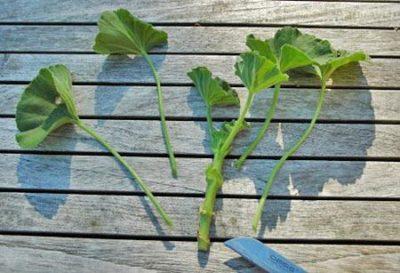

After a few days, the film is removed, and after a couple of months you can see the first shoots.
The last breeding method is the easiest. A geranium bush is divided into two equal parts with a sharp knife.
Roots and shoots should be on both halves. After dividing, the cut is processed with crushed activated carbon, and then new bushes are planted in the ground.
When geranium can be harmful
But from geraniums, not only benefits are possible, but also harm. Therefore, the treatment of young children is possible only with the help of external agents. Internal use is categorically contraindicated. In order not to harm the body, contraindications must be observed. It is strictly forbidden to use geranium for individual intolerance, pregnancy and lactation, old age, gastritis, ulcers or thrombophlebitis.
Before starting treatment with geraniums, it is necessary to measure its beneficial properties and harm. But in any case, if you start a plant in the house, then it will only benefit.
Signs and superstitions
In fact, there is not a single sign that would interfere or prohibit keeping this plant in the house. More and more people say that this miracle flower "listens" to the atmosphere in the house.
There is a sign that if rudiments began to appear on a flower, this is for a wedding, marriage, the beginning of a relationship or great love.
Pink pelargonium can help and bring together when a couple often quarrels, bored each other, or have reservations.
If a couple cannot have a child for a long time, then they buy white pelargonium. It should be placed in the bedroom of a married couple.
The red flower helps to find a lover, and for those who are already married, to find beauty and preserve it for years.
The flower will protect you from parting, protects the hearth, relieves you of evil talk.
If pelargonium blooms in the house, the young will marry her husband or the boy will marry.
In almost all peoples and beliefs, this flower is a symbol of love and home comfort.
Read also Net for hive bottoms
Feng Shui geranium
According to Feng Shui, geranium can reduce the negative impact and bad energy in the house, replacing it with a good sense of humor and supportive relationships. In other words, it protects from quarrels and conflicts, strengthens family ties, brings people together.
The best place for this flower is the southern windowsills. When it comes to bedroom placement, opinions differ across cultures. Some believe that in such a place there should be no flowers at all, others that geranium and the like are possible. If the bedroom is on the south side, then the geranium will be the place there.
This flower fills with vital energy, inhaling it a person "refills" in a positive way. The mood changes for the better, all unnecessary thoughts and burdens are discarded.
Let's sum up
That is, we can say that this is a universal plant that should be in every home. It will help not only clean the air and disinfect it from all kinds of bacteria and viruses, but also normalize the atmosphere in the house. It is geranium that is recommended as a universal plant for the bedroom and living room, nursery, as it is able to calm and reconcile all household members. Beautiful flowers can rekindle the cooled feelings of spouses and connect people who are separated. In addition, geranium is able to increase the creative cognitive abilities of children, eliminates quarrels and other children's conflicts. Thus, if you do not have pelargonium yet, be sure to get several copies.
Choosing a color
There are a lot of varieties of this plant, and the benefits and harm in the house also depend a little on what color the geranium blooms. So, red geranium is a powerful source of vitality. She is able to give you a huge supply of internal energy. People with whom it grows are less likely to be stressed, almost never lose heart. Red geranium heals household members from chronic fatigue and overwork, laziness, as well as most fears.
The mascot of lovers is pink pelargonium. This is a great gift for a person who seeks to find a soul mate or, conversely, carefully preserves the created happiness. Previously, girls wore pink geranium flowers in bags to attract their betrothed.
Not everyone likes the purple color of the petals, but this plant fills the human soul with spirituality. Purple flowers distract from worldly affairs and daily hustle and bustle. Under the influence of its energy, a person is able to delve into the spiritual sphere.
White geranium is a symbol of pure love and fertility; it is customary to give it to brides on their wedding day. If a couple intends to conceive a child, then they are advised to keep pelargonium in the bedroom.
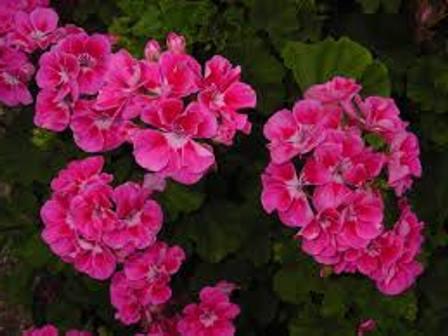

Cultural and wild plant species, their use in the treatment of various ailments
In addition to home room geranium, the following types are often used in folk medicine:
- Swamp... It grows in Central, European and Southern Europe. Prefers wet places near swamps, as well as in willows. It has astringent, antiseptic and anti-inflammatory effects.
- Forest. It is found in the temperate climatic zone of Russia, Siberia and the North Caucasus. Used to stop bleeding and rheumatic pain. Helps with diarrhea, digestive disorders.
- Lemon. Its other name is pink pelargonium. Lemon geraniums are grown at home. It has a pleasant lemon aroma. It is used as a deodorant, antiseptic, hemostatic and wound healing agent. Able to relieve the symptoms of otitis media, acute respiratory infections, headaches, inflammation of the nasopharynx. Aromatic teas are prepared from lemon geraniums.
- Non-blooming - fragrant geranium. This geranium does not bloom. Has carved leaves, which, when watered or touched by a person, begin to smell like lemon balm. Scented geranium purifies the air. Has antidepressant properties.Its smell increases mental and physical activity, evens out the psycho-emotional background, eliminates the feeling of fear, restores the nervous system in case of exhaustion.
Helps to regain self-confidence and eliminate inferiority complex. Also used as an antiseptic, anti-inflammatory agent. Non-blooming geranium is used for otitis media that begin with a cold and acute respiratory infections.
The chemical composition of all types of geraniums contains valuable substances of the flavonoid group with an antioxidant effect - catechins and tannins.
Geranium can be used to make oil, infusions, decoctions and alcoholic tinctures for external and internal use.
Energy
A lot of speculation is associated with this moment, and some call this plant a healer, while others, on the contrary, a vampire. Let's try to find out what geranium is in the house. Signs and superstitions are one thing, but folk wisdom, which for centuries has noticed the properties of various plants, very clearly says that geranium should be in every home. First of all, because it has a vigorous and active energy. Where it grows, there is no place for despondency, aggression and squabbles. Therefore, from the point of view of bioenergetics, it is a real keeper of the hearth, tranquility and peace. It teaches you to treat what is happening with humor, and to other people - with respect and goodwill. According to popular beliefs, this plant protects your home from evil spirits.
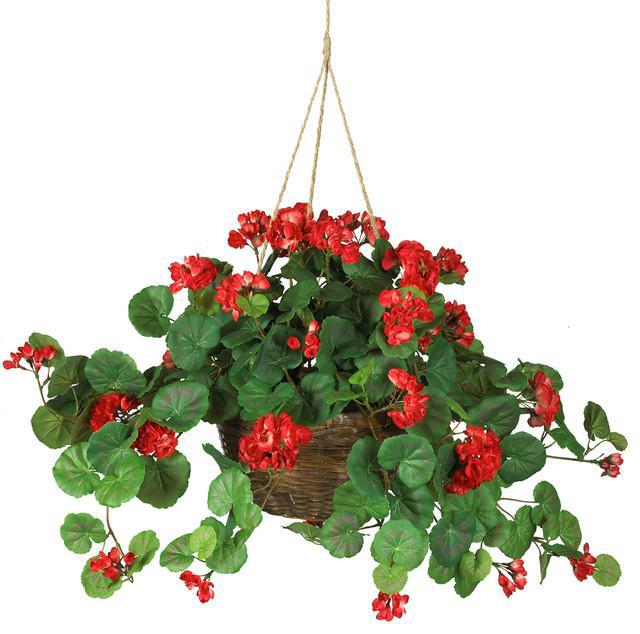

Is it possible to keep at home and where to put
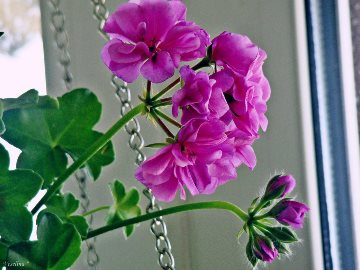

Many people ask the question - is it possible to keep this common flower at home, is it safe? Based on the experience of our grandmothers and great-grandmothers, we can safely answer - even necessary. True, experts in the eastern practice of feng shui recommend to settle this plant in certain parts of the house: the zone of love (south-west side of the apartment), the zone of children and creativity (west) or the zone of money (on the south-east side). However, there are other tips for proper geranium placement:
- A white, pink or purple pelargonium flower can be placed in any part of the room, but it is better to put the red one on the windowsill so that it can be clearly seen from the street. So the plant will be able to protect the owners from the evil eye, damage and bad thoughts of ill-wishers.
- The proximity of geraniums with other flowers, for example, with an azalea bush or a schlumberger (Decembrist cactus), will only enhance its positive magical properties.
- In a private house, it will be very useful to place pots with geraniums on both sides of the porch. You can plant pelargonium on a flowerbed in front of the windows - its flowering will delight the owners of the house all summer.
- Astrologers say that geranium is best suited for its energy to people born under the sign of Aries. To cope with problems and calm down, she helps the signs of the water element - Pisces, Aquarius, Scorpions. And for the rest it will be an excellent amulet for all occasions.

